- Visibility 134 Views
- Downloads 10 Downloads
- DOI 10.18231/j.aprd.2020.033
-
CrossMark
- Citation
Prosthetic augmentation of sunken cheeks using hollow PVC pipe cheek plumpers – A case report
- Author Details:
-
Aarti Mehta *
-
Sunil Kumar MV
-
Harikesh Rao
Introduction
Esthetics has become pre-eminently an important part in the field of dentistry. This is largely in response to negative social and psychological consequences that follow unattractive facial looks.[1] Therefore, while prostheticaly rehabilitating any edentulous patients, missing teeth and facial esthetics are parallely restored. [2]
Cheeks are usually the most prominent part of the face that are supported by the teeth, ridges and muscles, there by having a critical role to play in facial esthetics. However loss of molars, complete edentulism, age related loss of muscle tone, weight loss are certain factors leading to concavities and hollowing out of cheeks. This results in reduced or lost cheek fullness giving a slumpy and skinny appearance to the face and makes the patient look older leading to unfavourable socio-psychological effects. [1], [2]
Normally in complete edentulous patients, the lost facial form and contours are usually re-established by restoring vertical jaw relation records and adequate contouring and extension of denture flange.[3] Despite that, in geriatric patients with excessive loss of facial fullness and hollowed cheeks, an extra support to flaccid oro-facial muscles is required. This is achieved prosthetically using cheek plumpers with complete denture. [4], [5], [6] Use of artificial prosthesis for different augmentation procedures have also been documented in various literatures of maxillofacial studies. [7], [8], [9]
Cheek plumpers are usually a single unit prosthesis, fabricated in premolar-molar region that acts like a sub-structure or buttress over which the cheeks are supported and prevented from collapsing. [10] The major shortfall of this design is an increase in the over-all weight of the prosthesis due to addition of extra quantity of denture base resin that may lead to over loading of residual ridges and adversely affect the retentive property of denture.
To overcome this drawback, a weight reduction approach has been tried. This case report illustrates the use of PVC pipe for fabricating hollow cheek plumper prosthesis in a patient with maxillary complete edentulous arch and sunken cheeks.
Case Report
A 63-years old male patient reported to the department of prosthodontics at Jaipur Dental College, Jaipur, Rajasthan, wanting the replacement for his missing teeth. History revealed that he had lost his teeth over a period of 2-3 years due to the problems of periodontal origin. The patient’s main concern was the restoration of his lost masticatory function and also insisted on restoring his lost facial fullness due to sunken cheeks. Intra-oral examination of the patient had revealed completely edentulous maxillary arch and partially edentulous mandibular arch with remaining posterior natural teeth. ([Figure 1], [Figure 2]). While the extra oral examination showed flaccid and unsupported oro-facial musculature resulting in slumped and sunken cheeks ([Figure 3]). The treatment plan was formulated in accordance with the patient’s need. Complete denture with hollow cheek plumpers was planned for maxillay arch which would be fabricated using heat resistant PVC pipes (figure 4). This would help to augment the sunken cheeks by providing artificial support intra-orally and also reduce the overall weight of prosthesis (the gross weight of each PVC pipe used was 1.9 gm approx. depicted in [Figure 4]) that would otherwise be heavy due to the added weight from polymerised resin in cheek plumper region. For mandibular arch a removable partial denture (gingival prosthesis) was planned that replaced the missing natural teeth in anterior region while posteriorly it extended as gingival mask for prosthetic coverage of exposed roots due to gingival recession.
In this article the procedures performed during fabrication of maxillary complete denture with hollow cheek plumpers using PVC pipes have been illustrated.
The primary impression of maxillary arch was made using impression compound(Y-Dent, MDM Trading corporation, Delhi) followed by custom tray fabrication using self-polymerizing acrylic resin (DPI RR Cold Cure, DPI, Mumbai, India)on primary cast. Border moulding with low fusing impression compound (DPI Pinnacle, The Bombay Burmah Trading Corporation Limited, Mumbai, India) was done and final impression was made using zinc-oxide impression paste (Impression Paste, DPI, Mumbai, India). Jaw relations were recorded followed by the waxed-up denture try-in procedure for the first trial of occlusion and esthetics. There after modeling wax was softened and molded in a cylindrical shaped cheek plumpers which were then tempered and attached to a distobuccal flange region of maxillary trial denture on both sides. This was then tried in the patient’s mouth and necessary cheek lip movements were made. Extra-orally the required cheek fullness and support was evaluated for facial esthetics. After the patient has accepted the desired changes in his facial appearance, the waxed up denture with cheek plumpers was taken for laboratory procedures. Routine flasking and de-waxing was done. Heat resistant hollow PVC pipes of 4mm diameter were secured in the mould space created in the area of cheek pulmpers using cold cure resin plugs which can fit into the plug holes of wax strip for orientation of PVC pipes and also used for obliterating the entry holes of the hollow pipes ([Figure 5], [Figure 6]). The assembly is set as shown in the [Figure 7] and wax strip is carefully removed before the final packing. The self cure orientation plugs prevent the pipe’s surface to come in direct contact with the periphery of mold space. This clearance helps the heat cure acrylic resin to completely surround the external surface of hollow pipe without exposing it out to the cameo surface of the denture. Final packing was done using heat-polymerising acrylic resin (DPI, Mumbai, India) and the denture was finished and polished. The final prosthesis was then checked for any discomfort, loss of function, esthetics in patient’s mouth before denture delivery. ([Figure 8], [Figure 9])
The patient was educated about the prosthesis and trained for easy insertion and removal of the same. After assuring that the patient’s needs have been met, the prosthesis was delivered and he was recalled for subsequent regular check- ups to assess and attend to any discomforts due to dentures.
[Figure 10] depicts final result showing augmented cheek musculature in patient after prosthesis insertion and a drastic change in patient’s over-all appearance can be appreciated which otherwise looked more senile and slumped in pre-operative phase depicted by [Figure 3].
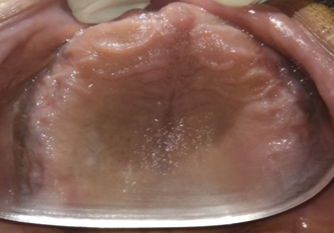
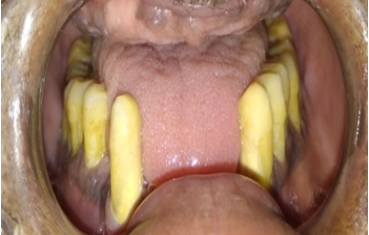
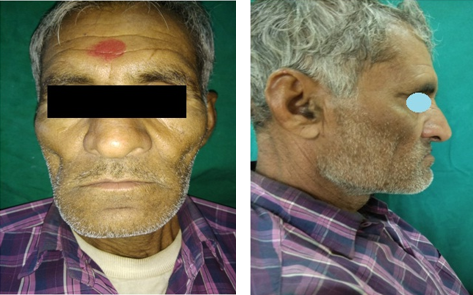
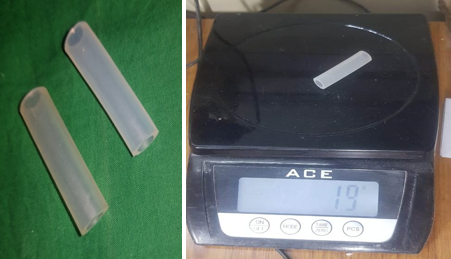
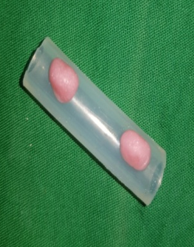
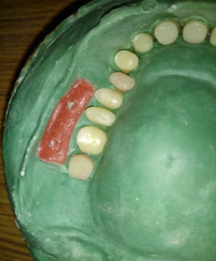
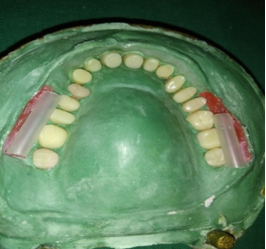
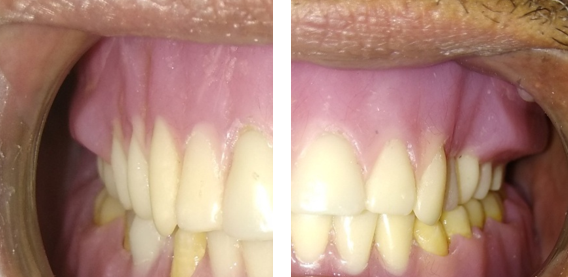
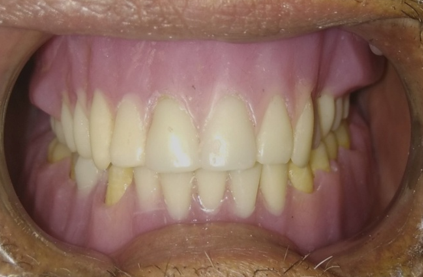
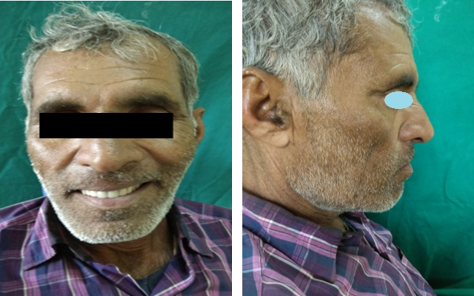
Discussion
Esthetics has become one of the salient elements in assuring success of any prosthodontic treatment. It is therefore important to understand and recognize various factors that affect facial appearance of the person.
Aging causes drastic alterations of face that includes tissue atrophy, thinning of skin and loss of subcutaneous fat, buccal fat pad, and exaggeration of creases and skin folds. [3]
Loss of teeth and alveolar ridge resorption in completely edentulous patients results in support-deprived oro-facial musculature, that collapses lower third of the face. The cheeks tend to move medially to meet the lateral encroaching tongue. This is also accompanied with deepening of naso-labial fold, depression of lips with evident wrinkles, drooped corners of mouth and loss of vermillion border, leaving the cheeks sunken and hollow. Also their form and contour are adversely affected due to loss of vertical dimension of occlusion. [11] Considering all the above factors, facial harmony and balance should be restored.
Despite of various treatment modalities available like, reconstructive plastic surgeries, botulinum toxin (BOTOX procedure), rehabilitations through implants etc., using cheek plumpers with complete denture prosthesis is an easy, non-invasive and cost effective means to support and lift the oral and facial musculature which otherwise are flaccid and sunken. Construction of cheek plumpers makes additional use of denture base resin that elevates its over-all weight. This hefty prosthesis has a detrimental effect on residual alveolar ridges that tend to resorb even faster under heavy load. Also, the increased weight amplifies the forces acting away from the foundation of maxillary arch, thereby interfering with denture retention. [12]
Therefore, in this case, the efforts were made to eliminate this extra weight by using light weight, heat resistant PVC pipes that rendered the prosthesis hollow in the region of cheek plumpers. Various other methods to create hollow cheek plumpers using salt, sugar, sawdust, and sand have also been discussed in the literature. [13], [14] However, unlike PVC pipes, these demand additional step of elimination and may be displaced to get incorporated in resin during compression moulding (packing) and final closure.
Initially, patient may find it difficult to insert and remove the prosthesis from the mouth but proper training and patient education with subsequent visits can overcome this problem easily.
Conclusion
It is the dentist’s capability to acknowledge and understand the needs of the patient and accordingly formulate the treatment plan. The prosthodontic aid elaborated in this clinical report has not only tried to restore the lost oral functions but also facial esthetics ensuring the re-establishment of patient’s mental, physical and social well being.
Acknowledgement
I would like to extend my gratitude to The Department of Prosthodontics and institution, Jaipur Dental College (MVGU) for providing necessary material and lab assistance for the case.
Source of Funding
None.
Conflict of Interest
None.
References
- J W Bains, J P Elia. The role of facial skeletal augmentation and dental restoration in facial rejuvenation. Aesthet Plast Surg 1994. [Google Scholar]
- G A Zarb, J Hobkirk, S Eckert, R Jacob. Prosthodontic treatment for edentulous patients-e-book: complete dentures and implant-supported prostheses. 2013. [Google Scholar]
- A L Martone. Effects of complete dentures on facial esthetics. J Prosthetic Dent 1964. [Google Scholar]
- S R Zwetchkenbaum, K Shay. Prosthodontic considerations for the older patient. Dent Clin North Am 1997. [Google Scholar]
- C H Jamieson. Geriatrics and the denture patient. J Prosthetic Dent 1958. [Google Scholar]
- R H Nariman, M K Sowmya, P D Krishna. A single complete denture with cheek plumpers to improve facial aesthetics. J Dent Res Sci Dev 2015. [Google Scholar]
- J B Lazzari. Intraoral splint for support of the lip in Bell's palsy. J Prosthetic Dent 1955. [Google Scholar]
- H Mukohyama, C Kadota, T Ohyama, H Taniguchi. Lip plumper prosthesis for a patient with a marginal mandibulectomy: a clinical report. J Prosthetic Dent 2004. [Google Scholar]
- S J Larsen, J F Carter, H A Abrahamian. Prosthetic support for unilateral facial paralysis. J Prosthetic Dent 1976. [Google Scholar]
- N N Keni, M A Aras, V Chitre. Customised Attachments Retained Cheek Plumper Prosthesis: A Case Report. J Indian Prosthod Soc 2012. [Google Scholar]
- F S Tautin. Denture esthetics is more than tooth selection. J Prosthetic Dent 1978. [Google Scholar]
- M O'Sullivan, N Hansen, R J Cronin, D R Cagna. The hollow maxillary complete denture: A modified technique. J Prosthetic Dent 2004. [Google Scholar]
- G D Costa, M Aras, V Chitre, P Rajagopal, A Nagarsekar. Cheek Plumper with a Salivary Reservoir: An Esthetic and Functional Treatment Option for a Xerostomic Patient with Sunken Cheeks. Dent 2015. [Google Scholar]
- P Sandebiksham, C R Kumar, D C Rao, G S Kumar. Esthetics redefined by cheek props-A case report. Ann Prosthodont Restor Dent 2017. [Google Scholar]
How to Cite This Article
Vancouver
Mehta A, MV SK, Rao H. Prosthetic augmentation of sunken cheeks using hollow PVC pipe cheek plumpers – A case report [Internet]. IP Ann Prosthodont Restor Dent. 2020 [cited 2025 Sep 13];6(3):157-161. Available from: https://doi.org/10.18231/j.aprd.2020.033
APA
Mehta, A., MV, S. K., Rao, H. (2020). Prosthetic augmentation of sunken cheeks using hollow PVC pipe cheek plumpers – A case report. IP Ann Prosthodont Restor Dent, 6(3), 157-161. https://doi.org/10.18231/j.aprd.2020.033
MLA
Mehta, Aarti, MV, Sunil Kumar, Rao, Harikesh. "Prosthetic augmentation of sunken cheeks using hollow PVC pipe cheek plumpers – A case report." IP Ann Prosthodont Restor Dent, vol. 6, no. 3, 2020, pp. 157-161. https://doi.org/10.18231/j.aprd.2020.033
Chicago
Mehta, A., MV, S. K., Rao, H.. "Prosthetic augmentation of sunken cheeks using hollow PVC pipe cheek plumpers – A case report." IP Ann Prosthodont Restor Dent 6, no. 3 (2020): 157-161. https://doi.org/10.18231/j.aprd.2020.033
